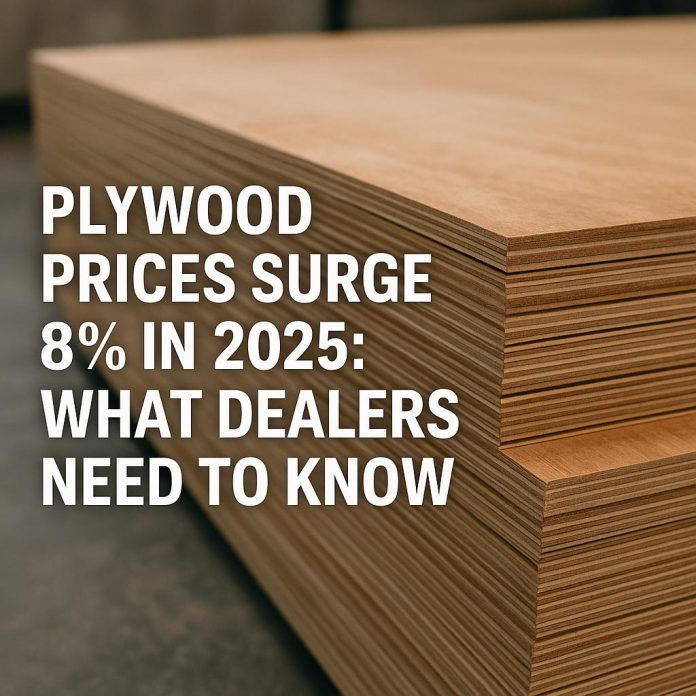The plywood industry has experienced an average 8% price increase across major grades in 2025, impacting both suppliers and dealers. This article explores the key drivers of the price surge, shares insights from manufacturers and trade experts, and outlines strategies dealers can adopt to stay competitive in a volatile market.
1. What’s Behind the Price Hike?
Plywood prices have steadily climbed over the last three months, affecting all major variants – MR (Moisture Resistant), BWR (Boiling Water Resistant), and BWP (Boiling Waterproof). Here’s why:
a. Raw Material Cost Increase
- Timber prices (especially Gurjan and Poplar) have risen by 10-15% due to seasonal supply shortages and increased freight charges.
- The cost of phenol and resins used in adhesive formulations has surged, partly due to increased import duties and volatile crude oil rates.
b. Labour & Energy Expenses
- Several manufacturing hubs in Haryana, Punjab, and Uttar Pradesh reported higher electricity tariffs and labour shortages, pushing up production costs.
- Post-election wage agreements in certain industrial zones have led to a 5–8% rise in factory labor costs.
c. Transport & Logistics
- Fuel prices have increased by approximately 6% over the last quarter.
- Shortage of transport vehicles due to high demand during the construction season has added pressure on freight rates.
2. What Manufacturers Are Saying
We spoke with a few industry leaders to understand the manufacturer’s perspective.
“Our production cost per sheet has gone up by ₹12–₹15 due to raw material issues. We’re absorbing some of it, but the rest is being passed on to distributors.” Said a manufacturer from Yamunanagar“Dealers must educate their customers. These hikes are not arbitrary but based on genuine cost increases. The pressure is pan-India, not just regional.”
3. State-Wise Price Snapshot (April–June 2025)
| State | Avg. Price/Sheet | Q1 Price | Q2 Price | % Increase |
| Punjab | ₹2,700 | ₹2,500 | ₹2,700 | +8% |
| Gujarat | ₹2,600 | ₹2,400 | ₹2,600 | +8.3% |
| Maharashtra | ₹2,800 | ₹2,600 | ₹2,800 | +7.7% |
| Tamil Nadu | ₹2,750 | ₹2,550 | ₹2,750 | +7.8% |
| West Bengal | ₹2,700 | ₹2,500 | ₹2,700 | +8% |
Prices given here for reference only for MR-grade plywood sheets (8×4 ft).
4. What Dealers Should Do
a. Communicate Early with Clients
- Inform interior designers, contractors, and builders in advance about price fluctuations.
- Offer them alternative grades or brands to manage budgets.
b. Manage Inventory Smartly
- Stock up on fast-moving SKUs before further hikes.
- Avoid overstocking slow-moving premium boards during uncertain pricing periods.
c. Diversify Product Offerings
- Add MDF, WPC, or Laminated Boards as supplementary products to attract price-sensitive customers.
d. Educate Your Sales Team
- Train showroom staff to justify price increases with facts—raw material trends, GST impacts, etc.
- Use digital signage or flyers at the store entrance to explain the surge professionally.
5. Forecast for Q3 2025
Experts predict that prices may stabilize or see a marginal 2–3% rise in Q3 depending on:
- Monsoon impact on timber supply.
- International crude oil prices (affecting resin and chemical rates).
- Post-election policy shifts or transport reforms.
Keep an eye on:
- Potential GST slab rationalization on wood products.
- Import duty updates for chemical resins and timber.
Conclusion
The Q2 2025 plywood price hike is a result of multiple converging factors—raw material shortages, increased energy and logistics costs, and demand-supply mismatches. For dealers, the key is to stay informed, adapt pricing strategies, and communicate transparently with both suppliers and customers.
Stay tuned to LakdaUdyogDarshan.com for weekly plywood price updates and expert market insights.


